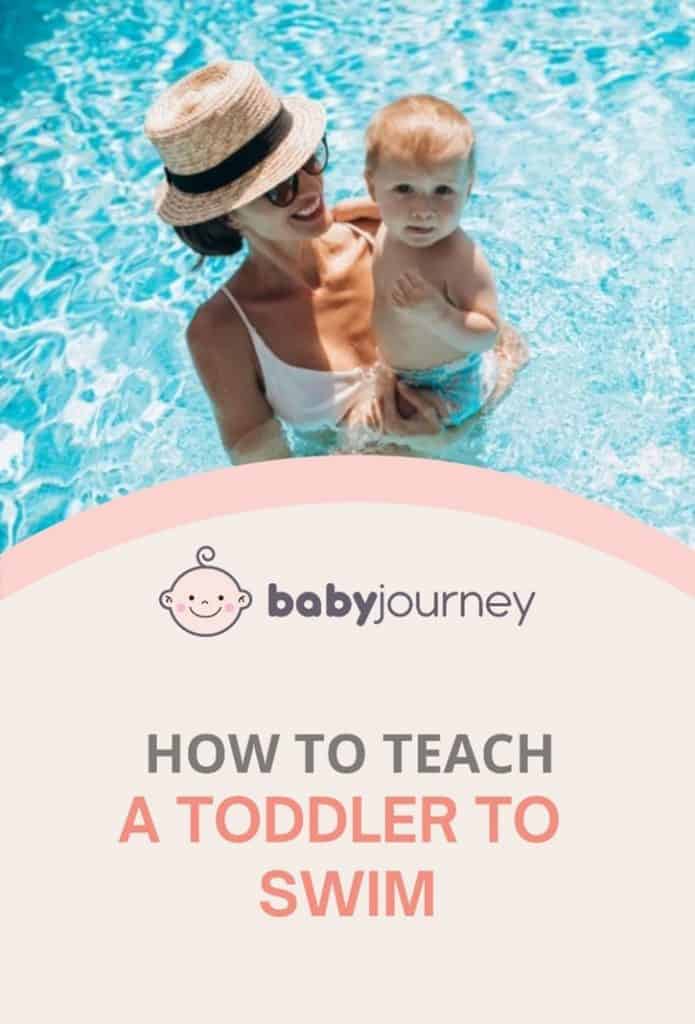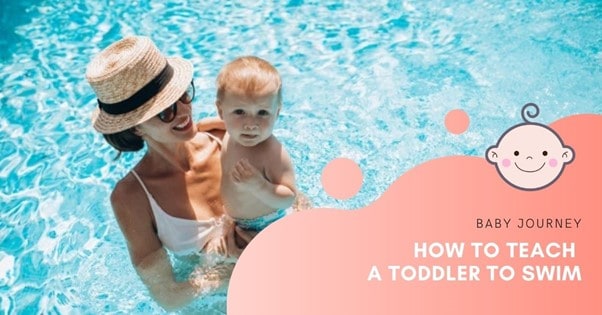Remember the first time you got into a swimming pool? What was that experience like for you?
Fear-inducing? Exciting? Both?
Such memories coupled with general safety concerns for your child might make you a bit apprehensive about their first swimming lesson. The good news is, you do not have to be. With the right approach, teaching toddlers how to swim can be a fun and beneficial learning adventure.
Of course, I would never ask you to take that leap without some tips. Come along and let’s explore some helpful basics on how to teach a toddler to swim.
- The Importance of Teaching Your Kid to Swim
- When Can You Teach Toddlers to Swim?
- How to Teach a Toddler to Swim
- Fun Activities You Can Use to Teach Swimming
- Water Safety Tips When Teaching Your Child to Swim
- Tips on Choosing the Right Swimming Instructor Classes
- Frequently Asked Questions on Teaching Toddlers to Swim
- Conclusion
The Importance of Teaching Your Kid to Swim
Swimming is a priceless skill. Helping your toddler learn to swim could offer benefits such as:
- Safety: According to the American Pediatric Association, teaching toddlers between the ages of 1-4 to swim is helpful in preventing toddler drowning incidents. [1] This is because trained kids have a better understanding of how to be safe around swimming pools.
- Fun: What’s a summer without the joy of hopping into a pool and just having a jolly good time? This is a forever gift that you could give to your kids by teaching them swimming skills. That way, they will also learn that playing with cell phones or digital gadgets isn’t the only entertainment around.
- A life skill: Just like driving, cooking, or cleaning up after themselves, swimming is a useful life skill for anyone to have.
- Health and fitness: Swimming is a full-body workout. It may be an easy and fun way to introduce your children to fitness for the good of their health. It is also great for improving body coordination apart from playing with toys.
- Bonding: Swimming with toddler children is a great way to spend time together, encourage communication and bond with them.
 fun family bonding activity | A Guide On How to Teach A Toddler to Swim | Baby Journey” class=”wp-image-16471″ width=”560″ height=”373″/>
fun family bonding activity | A Guide On How to Teach A Toddler to Swim | Baby Journey” class=”wp-image-16471″ width=”560″ height=”373″/>When Can You Teach Toddlers to Swim?
Pediatric experts recommend starting swimming lessons when toddlers are 1 year old or older.
Contrary to popular belief the infancy stage between 6 months to a year is not the best time to kick off swimming lessons. While infants may exhibit natural “swimming reflexes” they lack arm and leg coordination and their musculoskeletal structure is not strong enough at that age. Infants are also more fragile health wise and are more likely to be afraid of being in the water.
Water play sessions with safety devices like floaties may be a better idea for children below the age of 1.
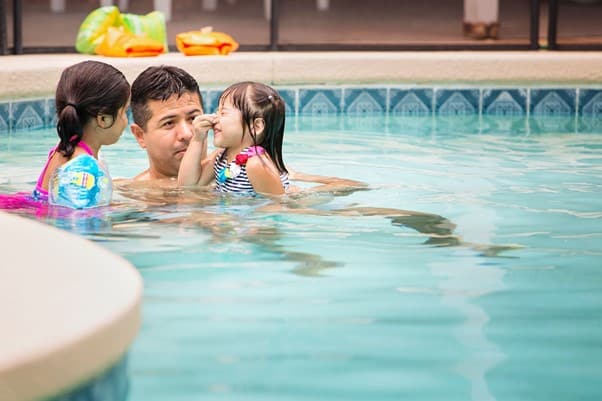
How to Teach a Toddler to Swim
Your toddler’s age will determine how much you can teach your child to swim. Teaching a 1-year-old to swim, for instance, will be more about the basics because they can only grasp so much. As parents, it is also important that you remember:
- Children have short attention spans, short sessions with breaks would be ideal.
- Teaching a kid to swim requires patience. They may not get it on the first or the fifth try, and probably cry or scream out of frustration but keep encouraging them.
- They need to be interested in learning to swim and feel comfortable with being in the pool, such as asking them to blow bubbles or hold their breath while staying in the water near the side of the pool as a short challenge. If your baby does not seem ready to learn to swim, do not force them into the swim lessons.
- Parents should stay within touching distance or position at all times; children learn better when they know you are there to keep them safe.
For some helpful insight on teaching skills to toddlers, I often refer to John Holt’s timeless classic, ‘How Children Learn’. You can find it here.
With that in mind, let us dive into how to teach your toddler to swim based on their age.
Beginner Lessons: Age 1-2
Beginner swim lessons are all about introducing your child to the water and helping them get comfortable with being in a bigger swimming pool.
Some teaching notes you can use in this stage include:
- Introduce them to water safety; Show them how to always carefully and safely use the swimming pool ladder and wall for assistance.
- Begin with some splash and play while they sit by the poolside. When they are comfortable learning to swim, let them know that you are starting the lesson.
- While holding your baby upright ask them to kick their legs underwater and paddle their arms.
- After that, you could ask them if they would like to listen out for fish in the water. This is to help your child get comfy with having their ears immersed. You can also
- Support their body and hold onto them as they immerse their head in the water. Make it brief so that it does not scare them and to prevent swimmer’s ear. [2]

Level 2: Age 3-4 / Toddlers Accustomed to Being in the Water
At this stage, your toddler is no longer foreign to swimming pools and tolerates water better after multiple beginner lessons. This provides a comfortable teaching platform or more advanced techniques. They include:
- Arm-leg coordination: While gently supporting them, ask your child to kick and paddle their arms at the same time. Do it in the upright position then switch to supporting them on their back and repeat.
- Holding breath under water: Ask your toddler to gently submerge their head underwater, hold their deep breath for 3-5 seconds and come up for air.
- Remind them to spit out any water that gets in their mouth while under water.
- Short swims: Once they have mastered immersing themselves and coming up to the surface of the water for air, you can encourage them to do it while kicking with their feet and paddling.
As they get more capable in their swimming skills at a point, gradually cut back your physical support but stay in the pool with them during practice.
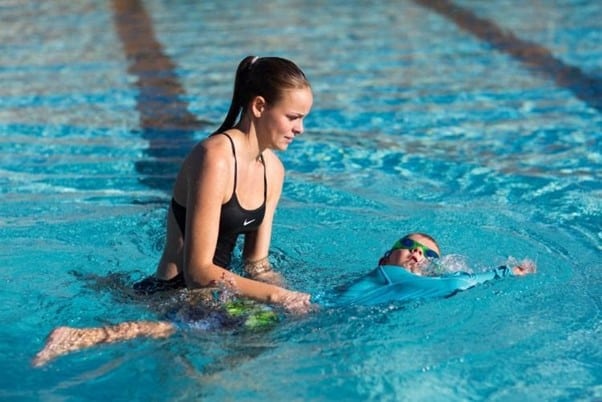
Level 3: Toddler Capable of Handling Themselves in Water
When your little one has learned to generally handle themselves in the water you can teach them how to:
- Safely dive into the water
- Tread water for a minute to longer
- Swim for increasingly longer distances with you by their side
- Exit the pool without the aid of a ladder
Fun Activities You Can Use to Teach Swimming
My favorite tagging about children is that they are predisposed to having a good time at all costs. So, if you make the lessons fun, they are more likely to become more committed to learning. You could try:
- The imaginary “fishies” trick or game: As opposed to simply asking your child to dip their head in water, ask them if they would like to check for “fishies” in the water. Asking them to try and grab the “fishies” could also reduce their fear of the water and motivate them to paddle their arms.
- Blowing bubbles or balls: This activity is especially good for children who love being in the water yet have some fear holding their breath under the water. Gently introduce them to games like blowing ping pong balls or bath toys to help them understand the strength of their breaths. You could also suggest for them to lower half of their head below the water surface and blow bubbles when they are more comfortable doing so.
- Sing-alongs: According to research studies, toddlers learn better through song better. [3] Try and make up little jingles to help your toddler remember what to do and maintain focus. Music also generally makes the practice session livelier. You could also let your child sing in the water.
Water Safety Tips When Teaching Your Child to Swim
The safety of your baby is more important than any skill they could ever learn. As you teach your toddler to swim here are some crucial safety tips to keep in mind.
- Never leave your child in the water by themselves, even if they wear a float. If you have to get out of the pool to take a call or attend to another child, take them out of the water as well and hold onto them.
- Teach your babies that it is never okay to get in the pool without an adult present.
- Always ensure that the pools you use are well treated and cleaned regularly. Look out for chlorine allergies or any negative reactions your child may have to swimming pools.
- Seek your pediatrician’s advice if your child has health conditions such as asthma or epilepsy to prevent the risk of drowning, since they will have trouble trying to hold their breath in water.
- Consider using swimming safety devices especially in the introductory stages. I have particularly found SwimSchool trainers to be really helpful. You can check them out here.
Tips on Choosing the Right Swimming Instructor Classes
It could be that you cannot swim or your schedule simply leaves no room for training sessions. In some instances, you might even simply feel safer if your child is taught by an expert. As you choose a swimming instructor for your child, here are two important factors to keep in mind.
- Certification: Ensure that your child’s instructor is well trained and certified by relevant authorities. Remember that teaching a 3-year-old to swim or any young children is not the same as teaching a 10-year-old. They should, therefore, specifically be trained to handle toddlers.
- Teaching skills: Your choice should not only be guided by whether your instructor knows how to teach a kid to swim but also how well they teach. Does your child feel comfortable around them? Are they patient and kind in their teaching?
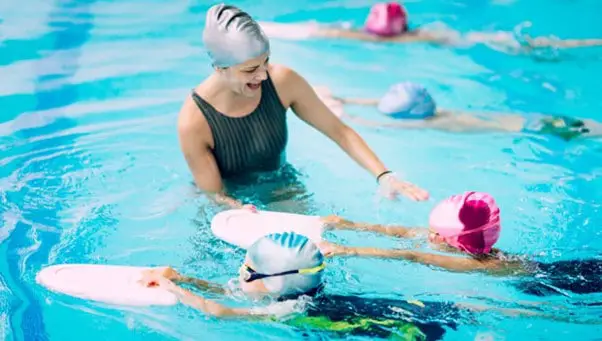
Frequently Asked Questions on Teaching Toddlers to Swim
Is it safe to dunk a baby in water?
No. Always inform your baby about what you are about to do first and ensure they are comfortable with you doing it.
What is the minimum age for swimming?
1 year. Each child should also be assisted to swim within their abilities. If a child is 2, work with the recommended guidelines on how to teach a 2-year-old to swim.
Are floats good for toddlers?
They are helpful in getting toddlers comfortable in swimming pools at the start. They are, however, not substitutes for adult supervision or swimmers training.
How long can my toddler stay in the pool?
Short spans of about 40 minutes at a time would be ideal to prevent fatigue. Allow some rest time as well after lunch or snack breaks before letting kids back in the pool.
Conclusion
The ability to swim is something I am forever grateful for. It has helped me battle insomnia, shed postpartum weight, and have some super fun times at the beach in summer. I look forward to my kids enjoying such joys now and in the future, and I am glad I get a chance to teach them. Has it been a smooth ride? Certainly not but we have found our footing and we are making progress.
You too can make it happen for your kids. It doesn’t matter whether you teach your child to swim or a trainer does, the goal is to get them to learn and become good swimmers.
Do let me know how it is going for you, will you?
—
